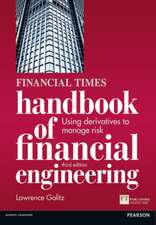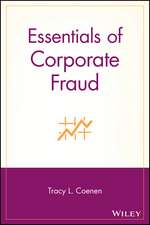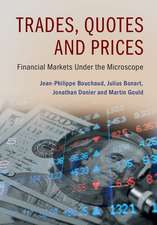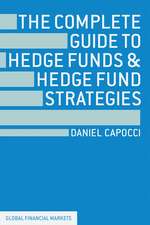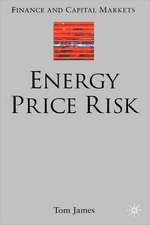The Eurodollar Futures and Options Handbook
Autor Galen Burghardten Limba Engleză Hardback – 16 iul 2003
Preț: 529.64 lei
Preț vechi: 621.01 lei
-15% Nou
Puncte Express: 794
Preț estimativ în valută:
101.36€ • 110.06$ • 85.14£
101.36€ • 110.06$ • 85.14£
Carte tipărită la comandă
Livrare economică 24-30 aprilie
Preluare comenzi: 021 569.72.76
Specificații
ISBN-13: 9780071418553
ISBN-10: 0071418555
Pagini: 350
Dimensiuni: 158 x 231 x 39 mm
Greutate: 0.84 kg
Editura: McGraw Hill Education
Colecția McGraw-Hill
Locul publicării:United States
ISBN-10: 0071418555
Pagini: 350
Dimensiuni: 158 x 231 x 39 mm
Greutate: 0.84 kg
Editura: McGraw Hill Education
Colecția McGraw-Hill
Locul publicării:United States
Cuprins
Foreword
Part One The Emergence of the Eurodollar Market
Chapter 1 The Emergence of the Eurodollar Market
The Revolution in Finance
The Futures Revolution
Key Money Market Developments
Why Eurodollars?
Eurodollar Futures
The Death of CD Futures and the Birth of Eurodollar Futures
The Market for Interest Rate Derivatives at the Beginning of the 21st Century
Exchange-Traded Money Market Futures and OTC Interest Rate Swaps
Options on Futures, Forward Rates, and Swaps
Markets around the World
Part Two Building Blocks: Eurodollar Futures
Chapter 2 The Eurodollar Time Deposit
Maturities and Settlement
Quotes
LIBOR and LIBID
Interest Calculations
Chapter 3 The Eurodollar Futures Contract
Contract Specifications
Contract Unit
Price Quote
Tick Size
Minimum Fluctuation
Listed Contract Months
Contract Month Symbols
Color-Coded Grid
Expiring versus Lead Contract
Trading Hours and Mutual Offset
Final Settlement Price
Last Trading Day
Value Dates
Additional Trading Facilities
Initial and Maintenance Performance Bonds
Volume and Open Interest
Other 3-Month Money Market Futures Contracts
Chapter 4 Forward and Futures Interest Rates
Deriving a Forward Rate from Two Term Deposit Rates
Locking an Effective Forward Lending Rate Using Eurodollar Futures
Important Differences between Forward and Futures Markets
Determining the Fair Value of a Eurodollar Futures Contract
Richness and Cheapness
Forward Rates Are Break-Even Rates
Yield Curve Trades
Finding the Forward Term Deposit Curve Implied by Today’s Futures Rates
Chapter 5 Hedging with Eurodollar Futures
The Tool Is a Eurodollar Futures Contract
Basic Hedge Algebra
Deriving Present and Forward Values from Eurodollar Futures Rates
Calculating a Forward Value (Terminal Wealth)
Calculating a Zero-Coupon Bond Price (Present Value)
Hedging or Replicating Forward Cash Flows
Forward Valuing the Gain or Loss on the Eurodollar Futures Contract
Present Valuing the Gain or Loss on a Floater
Hedging or Replicating Present Values of Cash Flows
Calculating the Price of a Zero-Coupon Bond
Calculating the Present Value of a Basis Point
Finding the Hedge for a Zero-Coupon Bond
Faster Hedge Ratio Calculations with Calculus
Pricing and Hedging a Coupon-Bearing Bond
Managing Hedge Ratios
As Rates Rise or Fall
As Time Passes
Practical Considerations in Real Hedges
The Stub Period
Date and Term Mismatches
Whole Contracts
Credit Spreads
Variable Credit Spreads
Chapter 6 Pricing and Hedging a Swap with Eurodollar Futures
Fixed/Floating Interest Rate Swaps
Notional Principal Amount
Cash Flows in Arrears
Periodicity
Spot and Forward-Starting Swaps
Day-Count Conventions and Swap Yields
Approaches to Pricing and Hedging Interest Rate Swaps
Cash Flow Approach
Hypothetical Security Approach
Pricing a Swap Using the Cash Flow Method
Hedging a Swap Using the Cash Flow Method
Primary Effects
Secondary Effects
Calculating Hedge Ratios
Hedge Ratios Are Dynamic
Pricing a Swap Using the Hypothetical Securities Method
Hedging a Swap Using the Hypothetical Securities Method
Floating Rate Liability
Fixed Rate Asset
Find the Hedge Ratios
Pricing and Hedging Off-the-Market Swaps
Convexity Differences between Forward and Futures Rates
Comparing Three Yield Curves: Forward, Zero Coupon, and Par Coupon
The Difference between Money Market Rates and Bond Yields
Part Three Eurodollar Futures Applications
Convexity Bias (Chapters 7 through 10)
Term TED Spreads (Chapters 11 and 12)
Hedging and Trading with Eurodollar Stacks, Packs, and Bundles (Chapter 13)
Hedging Extension Risk in Callable Agency Notes (Chapter 14)
Opportunities in the S&P Calendar Roll (Chapter 15)
Trading the Turn (Chapters 16 and 17)
Chapter 7 The Convexity Bias in Eurodollar Futures
Galen Burghardt and William Hoskins Research note originally released September 16, 1994
Synopsis
Introduction
Interest Rate Swaps and Eurodollar Futures
A Forward Swap
The Value of a Basis Point
Eurodollar Futures
Reconciling the Difference in Cash Flow Dates
Hedging the Forward Swap with Eurodollar Futures
The Other Source of Interest Rate Risk in the Forward Swap
Interaction between the Two Sources of Risk
Trading the Hedge
How Much Is the Convexity Bias Worth?
How Correlated Are the Rates?
Estimating the Value of the Convexity Bias
Calculating the Value of the Bias
Reconciling the Difference between a Swap and a Eurodollar Futures Contract
How One Would Pay for the Advantage
Translating the Advantage into Basis Points
A Workable Rule of Thumb
Applying the Rule of Thumb
The Importance of Time to Contract Expiration
The Cumulative Effect of All This Drift
How Sensitive Are the Estimates to the Assumptions?
Practical Considerations in Applying the Rule
The Importance of the Bias for Pricing Term Swaps
Biases in Forward Swap Rates
The Market’s Experience with the Convexity Bias
Now What?
Running a Receive Fixed, Pay Floating Swap Book
Marking a Swap Book to Market
Volatility Arbitrage
Evaluating Term TED Spreads
APPENDIX A Deriving the Rule of Thumb
APPENDIX B Calculating Eurodollar Strip Rates and Implied Swap Rates
Chapter 8 Convexity Bias Report Card
Galen Burghardt, William Hoskins, and Niels Johnson Research note originally released April 15, 1997
What Is the Convexity Bias?
How Have We Done?
Convexity Bias Greeks
Convexity Bias Delta
Convexity Bias Vega
Convexity Bias Theta
Chapter 9 New Convexity Bias Series
Galen Burghardt and Lianyan Liu Research note originally released February 1, 2002
Chapter 10 Convexity Bias: An Update
Chapter 11 Measuring and Trading Term TED Spreads
Galen Burghardt, William Hoskins, and Susan Kirshner Research note originally released July 26, 1995
Synopsis
TED Spreads
Simple TED Spreads
Term TED Spreads
Two Kinds of Term TED Spreads
Unweighted Eurodollar Strip Yields versus Treasury Yields
Weighted Eurodollar Strip Yields versus Treasury Yields
Implied Eurodollar Yield versus Treasury Yield
Fixed Basis Point Spread to Eurodollar Futures Rates
How Do These Rates Compare?
How Directional Is the Spread?
Trading the Spreads
Hedge Ratios
What to Do with the Stub
Overnight Financing
Term Financing
Carry and Convergence
Convexity
Forward Term TED Spreads
Term TED Spreads and Swap Spreads
APPENDIX Complete Operating Instructions for Calculating Term TED Spreads and Hedge Ratios
Chapter 12 TED Spreads: An Update
Chapter 13 Hedging and Trading with Eurodollar Stacks, Packs, and Bundles
Galen Burghardt, George Panos, and Fred Sturm Research note originally released December 15, 1999
Synopsis
Three Objectives
How Good Are Stack, Pack, and Bundle Hedges?
Curve-Augmented TED Spreads?
Hedging and Trading with Eurodollar Stacks, Packs, and Bundles
Basics: Dates, Names, Packs, Bundles, and Quotes
Contract Colors
Packs and Bundles
Quote Practices 1: Ticks
Quote Practices 2: Use Price Level for Individual Contracts
Quote Practices 3: Use Price Changes for Packs and Bundles
Unpacking Packs, Unbundling Bundles
Hedging with Stacks, Packs, and Bundles
What Happens to the Correlations?
Best Pack Proxies for Key Treasury Maturities
Horizon Matters
The Dangers of Decorrelation
Scaling Your Hedges to Reduce Hedge Error
Trading Curve TEDs
Calculating the Hybrid Spread
Looking for Opportunities
Chapter 14 Hedging Extension and Compression Risk in Callable Agency Notes
Galen Burghardt and William Hoskins Research note originally released March 24, 1995
Synopsis
Introduction
What Is the Exposure in a Callable Agency Issue?
Extension and Compression Risk
A Packaged Deal
What Is the Package Worth?
What Is the Risk Exposure?
Structuring a Hedge
The Option Is Tougher
Focus on Delta Hedging
Synthetic Forward Notes
Different Deltas
Example of Hedging a 10-Year, 8.5 Percent Coupon Note, Callable in 5 Years
Step 1: Find the Price of the Forward Note
Step 2: Find the Embedded Option’s Delta
Step 3: Calculate Spot Market Hedge Ratios
Step 4: Calculate Futures Hedge Ratios
Step 5: Adjust the Hedge as Interest Rates Change
The Costs and Risks of Delta Hedging
Risks in the Hedge
The Yield Spread between Agencies and Treasurys
What If There Is Little or No Call Protection?
Sometimes Strips of Eurodollar Futures Provide Better Hedges
Netting Positions
Adjusting the Hedges
Chapter 15 Opportunities in the S&P 500 Calendar Roll
Galen Burghardt and George Panos Research note originally released June 7, 1999
Synopsis
Save 15 Basis Points per Year on the Roll
Eliminate Interest Rate Risk in the Roll
Earn Superior Money Market Returns
The Value of the Calendar Spread
Fair Value of the Spread
Implied Financing Rate
How the Calendar Spread Has Behaved
What Is Your Exposure to Interest Rates?
Handling Rate Exposure in the Roll
Hedging against Interest Rate Risk
Cash Management and Portfolio Replication
Chapter 16 Trading the Turn: 1993
Galen Burghardt, Mike Bagatti, and Kevin Ferry Research note originally released October 25, 1993
Synopsis
What Is “the Turn”?
Two-Day Turns
Three-Day Turns
Four-Day Turns
Rate Behavior around the Turn
Effects on Eurodollar and LIBOR Futures Prices
Rule of Thumb for a 4-Day Turn
Rule of Thumb for a 3-Day Turn
Rule of Thumb for a 2-Day Turn
Implied Turn Rates
Implications for Futures Spreads
December LED Spread
December/January LIBOR Spread
December/March Eurodollar Spread
December TED Spread
Effect of the Turn on LIBOR and Eurodollar Volatilities
Theoretical Turn Volatility Premiums
So What?
The Risks in the Trade
Chapter 17 The Turn: An Update
Hedging the Stub
Part Four Building Blocks: Eurodollar Options
Chapter 18 The Eurodollar Option Contract
Option Expirations and Underlying Futures
Standard Quarterly Options
Serial Options
Mid-curve Options
Five-Year Bundle Options
Option Contract Specifications
Contract Unit
Price Quote
Tick Size
Minimum Fluctuation
Strike Price Increments
Listed Contract Months
Contract Type and Month Symbols
Sample Option Quotes
Trading Hours
Last Trading Day
Exercise of Option
Assignment
Chapter 19 Price, Volatility, and Risk Parameter Conventions
Pricing Options on Futures
Option Price (Market)
Volatility
Relative Rate Volatility
Rate (Basis Point) Volatility
Period Volatility
Implied Volatility
Risk Parameters
Delta
Gamma
Vega
Theta
Rho
Intrinsic and Time Value
Chapter 20 Caps, Floors, and Eurodollar Options
Chapter 21 Structure and Patterns of Eurodollar Rate Volatility
Historical, Implied, Realized, and Break-Even Volatilities
Term Structure of Eurodollar Rate Volatility
Volatility Calendar Spread Trade
Yield Curve Trade
Maturity Structure of Volatility (Volatility Cones)
Volatility Skews
Implied Rate Distributions
Chapter 22 Practical Considerations
Early Exercise
Cash Settlement and Exercise
Part Five Eurodollar Option Applications
Trading with Serial and Mid-curve Eurodollar Options (Chapters 23 and 24)
What Happens to Eurodollar Volatility when Rates Fall? (Chapters 25 and 26)
Hedging Convexity Bias (Chapter 27)
Chapter 23 Trading with Serial and Mid-curve Eurodollar Options
Galen Burghardt and Scott Lyden Research note originally released June 22, 1998
Synopsis
Eurodollar Strategy Triangle
FOMC and Other Volatility Trades
Spreads against OTC Treasury Options
LIFFE Joins the Crowd
The Full Constellation of Eurodollar Options
Standard Quarterly Options
Serial Options
Mid-curve Options
Serial 1-Year Mid-curve Options
The Beauty of This Design
The Eurodollar Strategy Triangle
June/Short June (A Yield Curve Spread)
Short June/Red June (A Time Decay Spread)
March/Red June (A Volatility Curve Spread)
Different Volatility Horizons
Mid-curve Options versus OTC Treasury Options
Eurodollar/Treasury Volatility Spread Trading
How Do You Compare the Volatilities?
How Do You Construct the Trades?
Some Things to Keep in Mind
LIFFE’s Options
Chapter 24 Serial and Mid-curve Options: An Update
Chapter 25 What Happens to Eurodollar Volatility When Rates Fall?
Galen Burghardt, George Panos, and Eric Zhang Research note originally released October 18, 2001
Background
Was Volatility Rich or Cheap?
Volatility and Rate Levels
Why Relative Rate Volatility?
What Is the Evidence?
Is it the Fed?
Practical Consequences
Chapter 26 Eurodollar Volatility: An Update
Chapter 27 Hedging Convexity Bias
Galen Burghardt and George Panos Research note originally released August 2, 2001
Synopsis
The Challenges
Overcoming the Challenges
Hedging a 4-Year Swap/Eurodollar Position
Gamma
Vega
Eurodollar Options
Gamma Mismatch?
The Choice?
Robustness?
Glossary
Index
About the Author
Footnotes
Chapter 1
Footnote 1
Chapter 3
Footnote 1
Footnote 2
Chapter 4
Footnote 1
Footnote 2
Footnote 3
Footnote 4
Footnote 5
Chapter 6
Footnote 1
Chapter 8
Footnote 1
Footnote 2
Chapter 11
Footnote 1
Footnote 2
Chapter 13
Footnote 1
Chapter 14
Footnote 1
Chapter 17
Footnote 1
Chapter 18
Footnote 1
Chapter 21
Footnote 1
Footnote 2
Chapter 23
Footnote 1
Footnote 2
Glossary
Footnote 1
Part One The Emergence of the Eurodollar Market
Chapter 1 The Emergence of the Eurodollar Market
The Revolution in Finance
The Futures Revolution
Key Money Market Developments
Why Eurodollars?
Eurodollar Futures
The Death of CD Futures and the Birth of Eurodollar Futures
The Market for Interest Rate Derivatives at the Beginning of the 21st Century
Exchange-Traded Money Market Futures and OTC Interest Rate Swaps
Options on Futures, Forward Rates, and Swaps
Markets around the World
Part Two Building Blocks: Eurodollar Futures
Chapter 2 The Eurodollar Time Deposit
Maturities and Settlement
Quotes
LIBOR and LIBID
Interest Calculations
Chapter 3 The Eurodollar Futures Contract
Contract Specifications
Contract Unit
Price Quote
Tick Size
Minimum Fluctuation
Listed Contract Months
Contract Month Symbols
Color-Coded Grid
Expiring versus Lead Contract
Trading Hours and Mutual Offset
Final Settlement Price
Last Trading Day
Value Dates
Additional Trading Facilities
Initial and Maintenance Performance Bonds
Volume and Open Interest
Other 3-Month Money Market Futures Contracts
Chapter 4 Forward and Futures Interest Rates
Deriving a Forward Rate from Two Term Deposit Rates
Locking an Effective Forward Lending Rate Using Eurodollar Futures
Important Differences between Forward and Futures Markets
Determining the Fair Value of a Eurodollar Futures Contract
Richness and Cheapness
Forward Rates Are Break-Even Rates
Yield Curve Trades
Finding the Forward Term Deposit Curve Implied by Today’s Futures Rates
Chapter 5 Hedging with Eurodollar Futures
The Tool Is a Eurodollar Futures Contract
Basic Hedge Algebra
Deriving Present and Forward Values from Eurodollar Futures Rates
Calculating a Forward Value (Terminal Wealth)
Calculating a Zero-Coupon Bond Price (Present Value)
Hedging or Replicating Forward Cash Flows
Forward Valuing the Gain or Loss on the Eurodollar Futures Contract
Present Valuing the Gain or Loss on a Floater
Hedging or Replicating Present Values of Cash Flows
Calculating the Price of a Zero-Coupon Bond
Calculating the Present Value of a Basis Point
Finding the Hedge for a Zero-Coupon Bond
Faster Hedge Ratio Calculations with Calculus
Pricing and Hedging a Coupon-Bearing Bond
Managing Hedge Ratios
As Rates Rise or Fall
As Time Passes
Practical Considerations in Real Hedges
The Stub Period
Date and Term Mismatches
Whole Contracts
Credit Spreads
Variable Credit Spreads
Chapter 6 Pricing and Hedging a Swap with Eurodollar Futures
Fixed/Floating Interest Rate Swaps
Notional Principal Amount
Cash Flows in Arrears
Periodicity
Spot and Forward-Starting Swaps
Day-Count Conventions and Swap Yields
Approaches to Pricing and Hedging Interest Rate Swaps
Cash Flow Approach
Hypothetical Security Approach
Pricing a Swap Using the Cash Flow Method
Hedging a Swap Using the Cash Flow Method
Primary Effects
Secondary Effects
Calculating Hedge Ratios
Hedge Ratios Are Dynamic
Pricing a Swap Using the Hypothetical Securities Method
Hedging a Swap Using the Hypothetical Securities Method
Floating Rate Liability
Fixed Rate Asset
Find the Hedge Ratios
Pricing and Hedging Off-the-Market Swaps
Convexity Differences between Forward and Futures Rates
Comparing Three Yield Curves: Forward, Zero Coupon, and Par Coupon
The Difference between Money Market Rates and Bond Yields
Part Three Eurodollar Futures Applications
Convexity Bias (Chapters 7 through 10)
Term TED Spreads (Chapters 11 and 12)
Hedging and Trading with Eurodollar Stacks, Packs, and Bundles (Chapter 13)
Hedging Extension Risk in Callable Agency Notes (Chapter 14)
Opportunities in the S&P Calendar Roll (Chapter 15)
Trading the Turn (Chapters 16 and 17)
Chapter 7 The Convexity Bias in Eurodollar Futures
Galen Burghardt and William Hoskins Research note originally released September 16, 1994
Synopsis
Introduction
Interest Rate Swaps and Eurodollar Futures
A Forward Swap
The Value of a Basis Point
Eurodollar Futures
Reconciling the Difference in Cash Flow Dates
Hedging the Forward Swap with Eurodollar Futures
The Other Source of Interest Rate Risk in the Forward Swap
Interaction between the Two Sources of Risk
Trading the Hedge
How Much Is the Convexity Bias Worth?
How Correlated Are the Rates?
Estimating the Value of the Convexity Bias
Calculating the Value of the Bias
Reconciling the Difference between a Swap and a Eurodollar Futures Contract
How One Would Pay for the Advantage
Translating the Advantage into Basis Points
A Workable Rule of Thumb
Applying the Rule of Thumb
The Importance of Time to Contract Expiration
The Cumulative Effect of All This Drift
How Sensitive Are the Estimates to the Assumptions?
Practical Considerations in Applying the Rule
The Importance of the Bias for Pricing Term Swaps
Biases in Forward Swap Rates
The Market’s Experience with the Convexity Bias
Now What?
Running a Receive Fixed, Pay Floating Swap Book
Marking a Swap Book to Market
Volatility Arbitrage
Evaluating Term TED Spreads
APPENDIX A Deriving the Rule of Thumb
APPENDIX B Calculating Eurodollar Strip Rates and Implied Swap Rates
Chapter 8 Convexity Bias Report Card
Galen Burghardt, William Hoskins, and Niels Johnson Research note originally released April 15, 1997
What Is the Convexity Bias?
How Have We Done?
Convexity Bias Greeks
Convexity Bias Delta
Convexity Bias Vega
Convexity Bias Theta
Chapter 9 New Convexity Bias Series
Galen Burghardt and Lianyan Liu Research note originally released February 1, 2002
Chapter 10 Convexity Bias: An Update
Chapter 11 Measuring and Trading Term TED Spreads
Galen Burghardt, William Hoskins, and Susan Kirshner Research note originally released July 26, 1995
Synopsis
TED Spreads
Simple TED Spreads
Term TED Spreads
Two Kinds of Term TED Spreads
Unweighted Eurodollar Strip Yields versus Treasury Yields
Weighted Eurodollar Strip Yields versus Treasury Yields
Implied Eurodollar Yield versus Treasury Yield
Fixed Basis Point Spread to Eurodollar Futures Rates
How Do These Rates Compare?
How Directional Is the Spread?
Trading the Spreads
Hedge Ratios
What to Do with the Stub
Overnight Financing
Term Financing
Carry and Convergence
Convexity
Forward Term TED Spreads
Term TED Spreads and Swap Spreads
APPENDIX Complete Operating Instructions for Calculating Term TED Spreads and Hedge Ratios
Chapter 12 TED Spreads: An Update
Chapter 13 Hedging and Trading with Eurodollar Stacks, Packs, and Bundles
Galen Burghardt, George Panos, and Fred Sturm Research note originally released December 15, 1999
Synopsis
Three Objectives
How Good Are Stack, Pack, and Bundle Hedges?
Curve-Augmented TED Spreads?
Hedging and Trading with Eurodollar Stacks, Packs, and Bundles
Basics: Dates, Names, Packs, Bundles, and Quotes
Contract Colors
Packs and Bundles
Quote Practices 1: Ticks
Quote Practices 2: Use Price Level for Individual Contracts
Quote Practices 3: Use Price Changes for Packs and Bundles
Unpacking Packs, Unbundling Bundles
Hedging with Stacks, Packs, and Bundles
What Happens to the Correlations?
Best Pack Proxies for Key Treasury Maturities
Horizon Matters
The Dangers of Decorrelation
Scaling Your Hedges to Reduce Hedge Error
Trading Curve TEDs
Calculating the Hybrid Spread
Looking for Opportunities
Chapter 14 Hedging Extension and Compression Risk in Callable Agency Notes
Galen Burghardt and William Hoskins Research note originally released March 24, 1995
Synopsis
Introduction
What Is the Exposure in a Callable Agency Issue?
Extension and Compression Risk
A Packaged Deal
What Is the Package Worth?
What Is the Risk Exposure?
Structuring a Hedge
The Option Is Tougher
Focus on Delta Hedging
Synthetic Forward Notes
Different Deltas
Example of Hedging a 10-Year, 8.5 Percent Coupon Note, Callable in 5 Years
Step 1: Find the Price of the Forward Note
Step 2: Find the Embedded Option’s Delta
Step 3: Calculate Spot Market Hedge Ratios
Step 4: Calculate Futures Hedge Ratios
Step 5: Adjust the Hedge as Interest Rates Change
The Costs and Risks of Delta Hedging
Risks in the Hedge
The Yield Spread between Agencies and Treasurys
What If There Is Little or No Call Protection?
Sometimes Strips of Eurodollar Futures Provide Better Hedges
Netting Positions
Adjusting the Hedges
Chapter 15 Opportunities in the S&P 500 Calendar Roll
Galen Burghardt and George Panos Research note originally released June 7, 1999
Synopsis
Save 15 Basis Points per Year on the Roll
Eliminate Interest Rate Risk in the Roll
Earn Superior Money Market Returns
The Value of the Calendar Spread
Fair Value of the Spread
Implied Financing Rate
How the Calendar Spread Has Behaved
What Is Your Exposure to Interest Rates?
Handling Rate Exposure in the Roll
Hedging against Interest Rate Risk
Cash Management and Portfolio Replication
Chapter 16 Trading the Turn: 1993
Galen Burghardt, Mike Bagatti, and Kevin Ferry Research note originally released October 25, 1993
Synopsis
What Is “the Turn”?
Two-Day Turns
Three-Day Turns
Four-Day Turns
Rate Behavior around the Turn
Effects on Eurodollar and LIBOR Futures Prices
Rule of Thumb for a 4-Day Turn
Rule of Thumb for a 3-Day Turn
Rule of Thumb for a 2-Day Turn
Implied Turn Rates
Implications for Futures Spreads
December LED Spread
December/January LIBOR Spread
December/March Eurodollar Spread
December TED Spread
Effect of the Turn on LIBOR and Eurodollar Volatilities
Theoretical Turn Volatility Premiums
So What?
The Risks in the Trade
Chapter 17 The Turn: An Update
Hedging the Stub
Part Four Building Blocks: Eurodollar Options
Chapter 18 The Eurodollar Option Contract
Option Expirations and Underlying Futures
Standard Quarterly Options
Serial Options
Mid-curve Options
Five-Year Bundle Options
Option Contract Specifications
Contract Unit
Price Quote
Tick Size
Minimum Fluctuation
Strike Price Increments
Listed Contract Months
Contract Type and Month Symbols
Sample Option Quotes
Trading Hours
Last Trading Day
Exercise of Option
Assignment
Chapter 19 Price, Volatility, and Risk Parameter Conventions
Pricing Options on Futures
Option Price (Market)
Volatility
Relative Rate Volatility
Rate (Basis Point) Volatility
Period Volatility
Implied Volatility
Risk Parameters
Delta
Gamma
Vega
Theta
Rho
Intrinsic and Time Value
Chapter 20 Caps, Floors, and Eurodollar Options
Chapter 21 Structure and Patterns of Eurodollar Rate Volatility
Historical, Implied, Realized, and Break-Even Volatilities
Term Structure of Eurodollar Rate Volatility
Volatility Calendar Spread Trade
Yield Curve Trade
Maturity Structure of Volatility (Volatility Cones)
Volatility Skews
Implied Rate Distributions
Chapter 22 Practical Considerations
Early Exercise
Cash Settlement and Exercise
Part Five Eurodollar Option Applications
Trading with Serial and Mid-curve Eurodollar Options (Chapters 23 and 24)
What Happens to Eurodollar Volatility when Rates Fall? (Chapters 25 and 26)
Hedging Convexity Bias (Chapter 27)
Chapter 23 Trading with Serial and Mid-curve Eurodollar Options
Galen Burghardt and Scott Lyden Research note originally released June 22, 1998
Synopsis
Eurodollar Strategy Triangle
FOMC and Other Volatility Trades
Spreads against OTC Treasury Options
LIFFE Joins the Crowd
The Full Constellation of Eurodollar Options
Standard Quarterly Options
Serial Options
Mid-curve Options
Serial 1-Year Mid-curve Options
The Beauty of This Design
The Eurodollar Strategy Triangle
June/Short June (A Yield Curve Spread)
Short June/Red June (A Time Decay Spread)
March/Red June (A Volatility Curve Spread)
Different Volatility Horizons
Mid-curve Options versus OTC Treasury Options
Eurodollar/Treasury Volatility Spread Trading
How Do You Compare the Volatilities?
How Do You Construct the Trades?
Some Things to Keep in Mind
LIFFE’s Options
Chapter 24 Serial and Mid-curve Options: An Update
Chapter 25 What Happens to Eurodollar Volatility When Rates Fall?
Galen Burghardt, George Panos, and Eric Zhang Research note originally released October 18, 2001
Background
Was Volatility Rich or Cheap?
Volatility and Rate Levels
Why Relative Rate Volatility?
What Is the Evidence?
Is it the Fed?
Practical Consequences
Chapter 26 Eurodollar Volatility: An Update
Chapter 27 Hedging Convexity Bias
Galen Burghardt and George Panos Research note originally released August 2, 2001
Synopsis
The Challenges
Overcoming the Challenges
Hedging a 4-Year Swap/Eurodollar Position
Gamma
Vega
Eurodollar Options
Gamma Mismatch?
The Choice?
Robustness?
Glossary
Index
About the Author
Footnotes
Chapter 1
Footnote 1
Chapter 3
Footnote 1
Footnote 2
Chapter 4
Footnote 1
Footnote 2
Footnote 3
Footnote 4
Footnote 5
Chapter 6
Footnote 1
Chapter 8
Footnote 1
Footnote 2
Chapter 11
Footnote 1
Footnote 2
Chapter 13
Footnote 1
Chapter 14
Footnote 1
Chapter 17
Footnote 1
Chapter 18
Footnote 1
Chapter 21
Footnote 1
Footnote 2
Chapter 23
Footnote 1
Footnote 2
Glossary
Footnote 1


